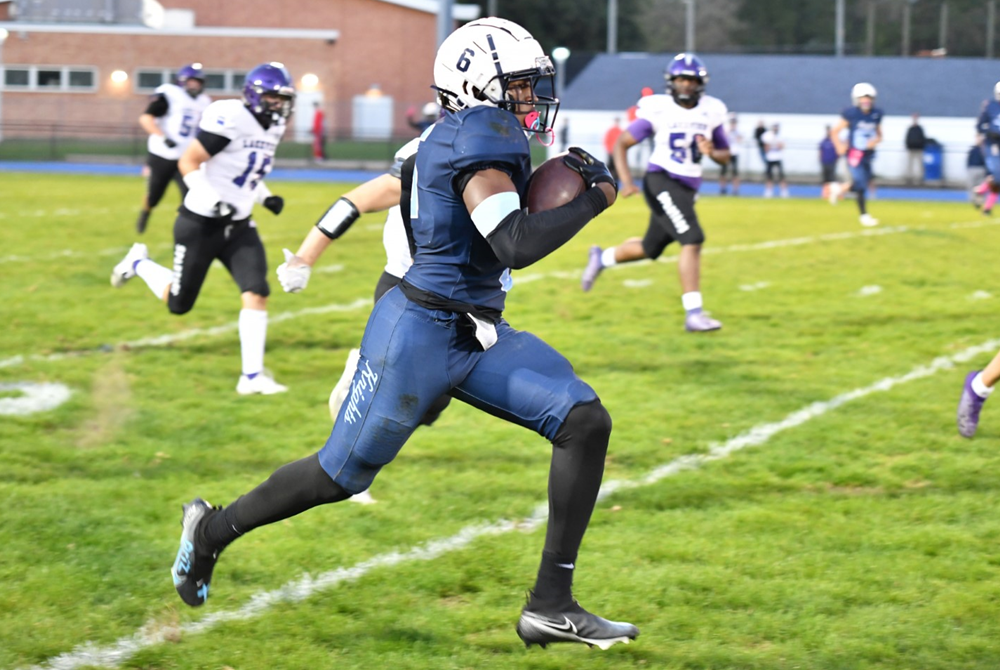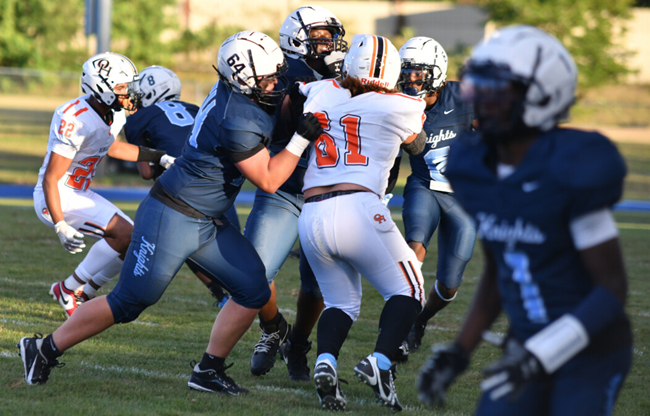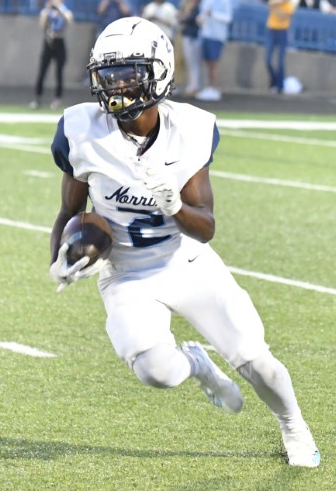
Talking Practice: Texas, Illinois Revise Policies
December 20, 2013
By Rob Kaminski
MHSAA benchmarks editor
Coaches and players in Texas and Illinois adapted to new football practice limitations this fall, with the Texas policy focusing on contact, and the Illinois regulation emphasizing length of preseason practices.
Following are the main changes those states put in place heading into the 2013-14 season:
The University Interscholastic League, which governs school sports in Texas, put into writing that, “During the regular season and postseason, no football player is allowed to participate in more than ninety (90) minutes of full contact practice per week,” effective with the first day of practice this fall.
The complete policy follows:
For the purposes of the of rule, "full contact" is defined as football drills or live game simulations where "live action" occurs. Live action, as defined by USA Football, is contact at game speed where players execute full tackles at a competitive pace taking players to the ground. A team may continue to dress in full pads for practice, but may only participate in live action drills and game time simulations no more than ninety minutes per athlete per week. It is assumed that when players are in shells (shorts, shoulder pads, and helmets) no live action drills or simulations will occur. This rule is intended to limit live action drills and simulations and not the number of practices a team may participate in full pads. A team may participate in "air," "bags," "wrap," and "thud" drills and simulations at any point. These contact levels are defined below:
• Air - Players should run unopposed without bags or any opposition
• Bags - activity is executed against a bag, shield or pad to allow for a soft-contact surface, with or without the resistance of a teammate or coach standing behind the bag.
• Wrap - Drills run at full speed until contact, which is above the waist with the players remaining on their feet.
• Thud - Same as wrap but tempo is competitive with no pre-determined winner and the players are not tackling to the ground.
 The rule came to the UIL Legislative Council as a recommendation from the UIL Medical Advisory Committee, a permanent advisory committee to the Legislative Council which meets twice each year to discuss and review safety policies for UIL participants. The committee, which is made up of leading medical professionals in various specialties and includes representatives from the Texas High School Coaches Association, the Texas Girls Coaches Association, and the Texas State Athletic Trainer Association, unanimously recommended this limitation in full-contact football practice.
The rule came to the UIL Legislative Council as a recommendation from the UIL Medical Advisory Committee, a permanent advisory committee to the Legislative Council which meets twice each year to discuss and review safety policies for UIL participants. The committee, which is made up of leading medical professionals in various specialties and includes representatives from the Texas High School Coaches Association, the Texas Girls Coaches Association, and the Texas State Athletic Trainer Association, unanimously recommended this limitation in full-contact football practice.
The rule formulates into a formal policy the existing actions of the majority of coaches across Texas, and most coaches have had to make few adjustments, if any. In fact, according to a story on statesman.com, the proposal caused more of an uproar on social media than from coaches.
“It’s not going to affect us in anyway,” Vandegrift HS coach Drew Sanders said in the story. “Most good coaches were way below that 90-minute amount already. Prior to legislation we still monitored it ourselves – the only change is now we have to keep up a log more publicly.”
Illinois put standards in place for its first 14 days of football practices, known as the state’s Preseason Football Acclimatization Practice Period. At the core of the policy is a three-hour practice limit for the first five days, during which teams can also conduct a one-hour walk-through.
 Teams must observe a minimum two hours rest between the practices and walk-throughs. Players may wear helmets only on the first two days, then helmets and shoulder pads for the next three. From days seven through 14 of the acclimatization period, schools may practice for a maximum of five hours per day, as long as that day is followed by a three-hour day, or an off day. During the five-hour days, no session can last more than three hours and must include a two-hour break between practices. Full pads may be worn for the final seven dates leading up to the first contest.
Teams must observe a minimum two hours rest between the practices and walk-throughs. Players may wear helmets only on the first two days, then helmets and shoulder pads for the next three. From days seven through 14 of the acclimatization period, schools may practice for a maximum of five hours per day, as long as that day is followed by a three-hour day, or an off day. During the five-hour days, no session can last more than three hours and must include a two-hour break between practices. Full pads may be worn for the final seven dates leading up to the first contest.
“This policy was the result of a collaborative effort between the IHSA Sports Medicine Advisory Committee and the Football Advisory Committee,” said SMAC committee member and University of Illinois Associate Professor of Orthopedic Surgery Dr. Preston M. Wolin. “The guidelines are based on the most recent scientific evidence, as well as the expertise of the coaches who will help implement them. Both committees believe the guidelines represent a significant positive contribution to the health of our athletes.”
“This new policy undoubtedly changes the way we, as coaches, approach preseason practice,” said Metamora HS coach Pat Ryan, who is a member of the FAC and a past President of the Illinois High School Football Coaches Association. “Coaches have to get more creative with when and how they schedule practices, as well what they do with their time. The proposals were strongly supported by both committees. It is a crucial final step to the process of being able to effectively prepare our teams in a safe manner. Change is always difficult, but the game is changing and we need to adapt to continue to put the safety of our players first.”
The IHSA offered multiple interactive online webinar meetings for high school coaches leading up to the start of practice where questions were answered, along with further clarifications on the policy and the science behind it.
“I think most coaches understood that changes were on the horizon,” said IHSA Executive Director Marty Hickman. “We wanted to be in a position to give our coaches as much information as possible to make sure they are comfortable with the new policy. Their input will be critical moving forward as we develop educational materials, like a best practices presentation. I commend our committees on a policy that is supported by medical experts, football coaches and school administrators.”

Struggle Transforming Into Success as Loy Norrix Builds Best Season since 1990s
By
Pam Shebest
Special for MHSAA.com
October 22, 2024
KALAMAZOO — Over Lorenzo Robertson’s first three years as head coach, the Kalamazoo Loy Norrix football team won a total of three games.
 His patience and guidance have paid off this year, leading to the Knights' first five-win season since 1998.
His patience and guidance have paid off this year, leading to the Knights' first five-win season since 1998.
A win against crosstown Southwest Michigan Athletic Conference East foe Kalamazoo Central in Friday’s regular-season finale would clinch an outright league championship for the Knights and potentially provide enough boost to get them back into the MHSAA Playoffs for the second time in school history – and first since 1997, when Loy Norrix featured future pros (Todd) T.J. Duckett and Little John Flowers.
Both Loy Norrix and Kalamazoo Central are 5-3 overall and 3-0 in SMAC East play heading into this weekend. The Knights finished 1-7 a year ago and entering this fall had won a combined 10 games over the last 12 – but they’ve guaranteed their first winning regular season in 26 years.
“We turned it around with a new commitment to the classroom,” Robertson said. “A lot of our kids are (now academically) eligible whereas when I got here, a lot of our kids struggled to keep the lower levels eligible. Those kids are now seniors, and they’re all doing well.”
Robertson said when he was hired, athletic director Andrew Laboe told him one of the key focuses was to get the players stronger.
When the new coach realized there was no weight training program, he started one.
“Where I come from (Bloomfield Hills Lahser, Pontiac and Dearborn Heights Robichaud), weights were very important to the point that we had a class for it during the school day for the football team and those that wanted to take the class that weren’t football,” Robertson said.
 Robertson also implemented offseason training, and during the second summer camp this year he realized this could be the turnaround season.
Robertson also implemented offseason training, and during the second summer camp this year he realized this could be the turnaround season.
“I knew the boys were getting it quickly, and we were able to move fast through the summer,” he said. “Because they had it down through the summer, when the season started, we hit the ground running.
“During our scrimmages, we were miles ahead of the teams we scrimmaged, though they were good teams. I could tell we were ready to go; we were moving fast. I knew that would carry over, just watching them in the summertime.”
Robertson also makes sure the players know the team’s history.
“Our coaches do a good job of researching,” he said. “Every team we play, we give (players) stats on when was the last time we beat ’em, how many times through the years, what’s our record down through the years. We teach these kids history of the Norrix program before we play.”
Before Robertson, things got so bad that in 2020 the football team, struggling to field players, left the SMAC and played as an independent.
This year, after four seasons away, the Knights are back in the conference.
“After our first SMAC game (we felt more competitive) because people were saying you won’t survive in the SMAC – and we come to the SMAC and it’s our best year,” said senior wide receiver/safety Rashad Waller. “That was really when I knew, oh yeah, I know this is it.”
A four-year varsity player, Waller said he stuck it out through the lean seasons because he knew things were bound to improve.
As a freshman, “watching behind the older guys and realizing they don’t have the time (to improve), I don’t want to be that guy,” he said. “I had to make my team lock in.
“Everybody in my class was tired of losing, so we just locked in and got it done. Coaching got a lot better, and guys really wanted it bad and made it happen.”
Waller already owns two school records. He returned two kickoffs for touchdowns to set a single-game record Sept. 20 against Mattawan. Both TD returns went for 99 yards, another all-time Norrix best and long enough to tie the MHSAA 11-player record for kickoff return distance as well.
Another senior, left guard/defensive tackle Will Dominianni, also weathered the previous three dismal varsity years.
 “We were a young program with a new head coach, so all of us kind of grew into our roles when it comes to the coaching staff and players as well,” he said. “That was a big thing.
“We were a young program with a new head coach, so all of us kind of grew into our roles when it comes to the coaching staff and players as well,” he said. “That was a big thing.
“We’ve really become a tight-knit group over the past couple years with all of us freshmen getting moved up on varsity our freshman year, so it was a bit like baptism by fire. We’ve all embraced the struggle together.”
Dominianni is one of the team’s rotating captains.
“Will Dominianni has probably been captain most of the year,” Robertson said. “David Jones is also having a great season.”
Jones, a junior running back/safety, is a second-year varsity player.
“The new guys we have are more dedicated (than previous years),” he said. “We’re coming together as a team. I knew it could change, and it did.”
Robertson said the success is a total team effort.
“We have a three-headed monster, sometimes a four-headed monster, at running back with David Jones, Maddox Pirochta, Christian Euceda. They have great per-carry averages.
“Whenever we get in trouble, we can give the ball to any of those three. Our running backs coach (Kierre Stinnette) does a great job rotating them in games.”
Robertson also credited his new defensive coordinator, Damion West, brought up from the junior varsity. “We promote from within,” Robertson said. “He’s pitched a couple shutouts with our defense. That will always keep you in games.”
Robertson added that the offensive line also has been a big improvement.
“This could be the best line I’ve had since being here, and we’re young with only two seniors in that group,” he said.
The quarterback position is shared by senior Jalen Evans and junior Jonavan Hare.
Besides working with players, Robertson also is building a rapport with parents, another key to the program’s success.
“When I came here, there was no parent booster program,” he said. “I’ve always known a parent booster group anywhere I’ve coached.
“We started that from scratch, and since that’s got rolling with our first group of parents, all the way to now has grown. Volunteerism has grown, and I always think that’s key to growing programs.”
 He said he’s also thankful the administration stuck with him during the lean years.
He said he’s also thankful the administration stuck with him during the lean years.
“I think they saw the change in the boys through the years; that kept me here,” he said. “The boys are doing better in school, better citizens and that’s also important.
“Sometimes wins and losses are put on the back burner to what kind of young man you are bringing into the world. Football is such a life-teaching sport.”
Robertson is steeped in life-teaching skills.
A retired minister, he currently commutes to Detroit for his job as captain in the Detroit Fire Department.
“(The fire department job) helps me not take anything for granted with all the tragedy I see and everything else that goes on,” he said. “It helps me care on a personal level, on a human level, for the boys.
"They see a working man, they see somebody who’s a family man that’s dedicated to them. I’ve got common sense, no-nonsense and I think that’s what attracts them.”
Once those players are attracted to the program, Waller has some advice for them.
“A lot of the younger guys complain about playing time, but coach is watching, so just keep your head on and keep grinding,” he said. “You’re gonna get your chance. Other than that, don’t worry about all the offers and all that stuff. It will come eventually.
“The first two years just work on getting your body right, getting fast and keep your grades up – and it will be the best two years of your life.”
 Pam Shebest served as a sportswriter at the Kalamazoo Gazette from 1985-2009 after 11 years part-time with the Gazette while teaching French and English at White Pigeon High School. She can be reached at [email protected] with story ideas for Calhoun, Kalamazoo and Van Buren counties.
Pam Shebest served as a sportswriter at the Kalamazoo Gazette from 1985-2009 after 11 years part-time with the Gazette while teaching French and English at White Pigeon High School. She can be reached at [email protected] with story ideas for Calhoun, Kalamazoo and Van Buren counties.
PHOTOS (Top) Kalamazoo Loy Norrix’s David Jones (6) sprints down the sideline during a Week 6 win over Battle Creek Lakeview. (2) Clockwise from top left: Knights coach Lorenzo Robertson, Will Dominianni, Rashad Waller and Jones. (3) Dominianni (64) helps protect his backfield against Grand Rapids Ottawa Hills. (4) Waller gets to the edge against St. Joseph. (Action photos by Steve Andrie; headshots by Pam Shebest.)

